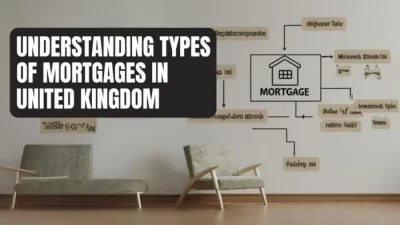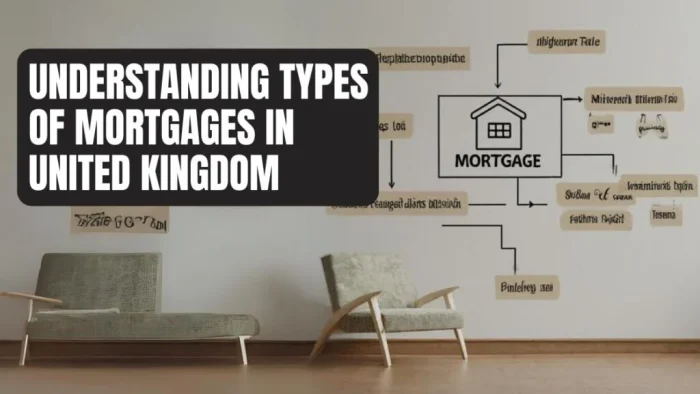In the United Kingdom, buying a property is a major financial commitment, and most people rely on mortgages to make homeownership possible. Understanding the different types of mortgages available in the UK is essential to making informed decisions when purchasing a home. Whether you’re a first-time buyer or an experienced homeowner looking to remortgage, this comprehensive guide will walk you through the key mortgage options available in the UK, their features, advantages, and how to choose the best one for your situation.
What is a Mortgage?
A mortgage is a loan secured against a property, typically repaid in monthly installments over a fixed term. In the UK, mortgages are commonly used to finance the purchase of a home. The amount you borrow is the loan’s principal, and you repay it with added interest over a specified period. If you fail to meet your mortgage payments, the lender has the right to repossess your home.
Different types of mortgages in the UK cater to varying financial circumstances and property goals, each with its pros and cons. Let’s dive into the main types of mortgages available.
1. Fixed-Rate Mortgages
A fixed-rate mortgage is one of the most popular choices among UK homebuyers. With this type of mortgage, the interest rate remains fixed for a set period, typically 2, 3, 5, or 10 years. This means that your monthly repayments stay the same, providing certainty and making it easier to budget.
Key Features:
- Fixed Interest Rate: The interest rate is locked for the agreed period.
- Term Length: Fixed-rate periods commonly last 2 to 5 years, but some lenders offer 10-year fixed-rate deals.
Advantages:
- Predictable Payments: Your monthly mortgage payments remain the same during the fixed period, offering stability.
- Protection from Rate Rises: If interest rates rise, your mortgage rate will not be affected.
Disadvantages:
- Limited Benefit if Rates Fall: If interest rates fall, you won’t benefit from lower rates.
- Early Repayment Charges: Exiting the mortgage early during the fixed period can result in early repayment charges (ERCs).
Fixed-rate mortgages are ideal for buyers who want certainty in their budgeting and are planning to stay in their property for a defined period.
2. Variable-Rate Mortgages
Variable-rate mortgages have interest rates that can fluctuate based on changes in the lender’s base rate or the Bank of England’s base rate. As a result, your monthly payments can go up or down depending on market conditions. Variable-rate mortgages come in a few different forms:
Standard Variable Rate (SVR) Mortgages:
- SVR mortgages are the default interest rates set by mortgage lenders and can change at any time. These rates are usually higher than fixed or tracker rates and can rise or fall without warning.
Tracker Mortgages:
- A tracker mortgage is a type of variable-rate mortgage that tracks the Bank of England base rate plus a set percentage. For example, if the base rate is 1%, and your tracker mortgage is set at 1.5% above the base rate, your interest rate would be 2.5%.
Discount Mortgages:
- Discount mortgages offer a reduced rate compared to the lender’s standard variable rate (SVR) for an introductory period, typically 2 to 5 years. After the discount period ends, the mortgage reverts to the SVR.
Advantages of Variable-Rate Mortgages:
- Potential Savings: If interest rates fall, your payments may decrease, potentially saving you money.
- No Early Repayment Charges (ERCs): SVR mortgages generally do not have ERCs, allowing you flexibility to overpay or switch to a different deal at any time.
Disadvantages of Variable-Rate Mortgages:
- Unpredictable Payments: Monthly payments can rise if interest rates increase, making it harder to budget.
- Higher Rates with SVR: Lenders’ SVRs tend to be higher than fixed or tracker rates.
Variable-rate mortgages are best suited for borrowers who can tolerate potential changes in their payments and want the flexibility to switch or pay off their mortgage early.
3. Interest-Only Mortgages
An interest-only mortgage allows you to pay only the interest on the loan each month for a specified period, often the first 5 to 10 years. During this period, your monthly payments are lower because you are not repaying the capital (the amount you borrowed). At the end of the term, you are expected to repay the original loan amount in full.
Key Features:
- Lower Initial Payments: Monthly payments are lower because only interest is paid, not the capital.
- Full Capital Repayment: At the end of the mortgage term, the full loan amount must be repaid.
Advantages:
- Lower Monthly Payments: Ideal for borrowers who want to reduce their outgoings in the short term.
- Investment Opportunities: Some borrowers invest their spare cash in the hope that returns will exceed the mortgage interest rate.
Disadvantages:
- Capital Still Owed: You must have a plan to repay the mortgage balance, which can be risky if investments don’t perform well.
- Tighter Lending Criteria: Lenders often have stricter requirements for interest-only mortgages, and not all borrowers qualify.
Interest-only mortgages are suitable for investors or those expecting to receive a lump sum in the future (e.g., from selling another property or a pension).
4. Offset Mortgages
An offset mortgage links your savings account to your mortgage. Instead of earning interest on your savings, the balance in your savings account is offset against your mortgage debt. This reduces the amount of interest you pay on your mortgage, potentially allowing you to repay it faster.
Key Features:
- Linked Accounts: Your mortgage and savings accounts are linked, and interest is charged on the net amount.
- Flexible Repayments: Some offset mortgages allow you to overpay or take payment holidays if you have built up sufficient savings.
Advantages:
- Interest Savings: The more you save, the less interest you pay, helping to pay off the mortgage sooner.
- Tax Efficiency: No tax is paid on the interest saved, making offset mortgages particularly attractive for higher-rate taxpayers.
Disadvantages:
- No Interest on Savings: You won’t earn interest on your savings, which may not be ideal if savings rates are high.
- Higher Rates: Offset mortgages tend to have higher interest rates than standard mortgages.
Offset mortgages are ideal for those with significant savings who want to use them to reduce their mortgage costs rather than earn interest on those savings.
5. Buy-to-Let Mortgages
Buy-to-let mortgages are specifically designed for people who want to buy a property to rent out to tenants rather than live in it themselves. These mortgages have different criteria than standard residential mortgages, and lenders often require larger deposits and charge higher interest rates.
Key Features:
- Larger Deposits: Typically, a deposit of 20-40% is required.
- Interest-Only Payments: Many buy-to-let mortgages are interest-only, meaning you only pay the interest each month and repay the capital when you sell the property or remortgage.
Advantages:
- Rental Income: The rent you receive from tenants can cover the mortgage payments, potentially providing a profit.
- Capital Growth: If property prices rise, the value of your investment can increase over time.
Disadvantages:
- Risk of Tenant Default: If your tenants don’t pay rent, you’ll still need to cover the mortgage payments yourself.
- Higher Interest Rates: Buy-to-let mortgages typically have higher rates than residential mortgages.
Buy-to-let mortgages are popular with property investors who want to generate rental income and benefit from long-term capital appreciation.
6. Remortgages
A remortgage involves switching your existing mortgage to a new deal, either with your current lender or a different one. People often remortgage to get a better interest rate, reduce monthly payments, or release equity from their property.
Key Features:
- New Mortgage Deal: Remortgaging allows you to switch to a better interest rate or change the terms of your loan.
- Equity Release: You can release equity from your home if its value has increased, giving you access to cash for home improvements, debt consolidation, or other needs.
Advantages:
- Lower Payments: Remortgaging can help you secure a lower interest rate, reducing your monthly payments.
- Flexibility: Allows you to change your mortgage terms to suit your current financial situation.
Disadvantages:
- Fees: Remortgaging often comes with fees, such as valuation, legal, and early repayment charges if you exit your current mortgage early.
Remortgaging is a good option for homeowners looking to save money on interest or unlock the value of their property.
Choosing the Right Mortgage for You
When selecting the best mortgage for your needs, consider factors such as:
- Your Financial Situation: Determine how much you can afford to pay each month and how stable your income is.
- Interest Rate Preferences: Decide whether you prefer the stability of a fixed

